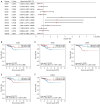Integrative analysis of the SOX family-related prognostic signature and immunological infiltration in prostate cancer
- PMID: 37701109
- PMCID: PMC10493808
- DOI: 10.21037/tcr-23-501
Integrative analysis of the SOX family-related prognostic signature and immunological infiltration in prostate cancer
Abstract
Background: Prostate cancer (PCa) remains a major prevalent cancer worldwide and has a poor prognosis. The sex-determining region Y (SRY)-related high-mobility group (HMG) box (SOX) family is a series of transcription factors (TFs) involved in regulating many biological processes (BPs). In tumors, however, SOX genes are frequently deregulated. Tumorigenic deregulation took place at the transcriptional, translational, and posttranslational levels. This leads them to be correlated to tumor progression and poor clinical outcomes in PCa. Nevertheless, the SOX family prognostic role in PCa still needs further investigation.
Methods: A SOX family-related prognostic signature was developed by performing LASSO (Least absolute shrinkage and selection operator) Cox regression analysis. The construction of a lncRNA-miRNA-mRNA regulatory axis for PCa was performed using a ceRNA network.
Results: Upregulation was observed in the expression of SOX4/8/11/12/14, while downregulation was observed for SOX2/5/7/13/15/30 in PCa. Consensus clustering identified four clusters of PCa patients based on these differentially expressed SOX family members. The constructed SOX family-related prognostic signature, which includes five SOX family members (SOX5/8/11/12/30), performed well in predicting PCa-patient prognosis. B cells, CD4+ T cells, CD8+ T cells, neutrophils, macrophages, and dendritic cell immune infiltration levels had a significant association with PCa-patient risk scores. Based on additional analysis, a significant association was also suggested between SOX family expression and tumor mutational burden (TMB), microsatellite instability (MSI), and drug sensitivity. By constructing a ceRNA network, a lncRNA SGMS1-AS1/miR-194-5p/SOX5 regulatory axis was developed for PCa.
Conclusions: Herein, a SOX family-related prognostic signature was identified and was found to perform well in predicting PCa-patient prognosis. A lncRNA SGMS1-AS1/miR-194-5p/SOX5 regulatory axis was also identified for PCa progression.
Keywords: SOX family; SOX5; prognostic signature; prostate cancer (PCa).
2023 Translational Cancer Research. All rights reserved.
Conflict of interest statement
Conflicts of Interest: Both authors have completed the ICMJE uniform disclosure form (available at https://tcr.amegroups.com/article/view/10.21037/tcr-23-501/coif). The authors have no conflicts of interest to declare.
Figures











Similar articles
-
Biological functions and therapeutic potential of SRY related high mobility group box 5 in human cancer.Front Oncol. 2024 May 21;14:1332148. doi: 10.3389/fonc.2024.1332148. eCollection 2024. Front Oncol. 2024. PMID: 38835366 Free PMC article. Review.
-
Multi-Omics Approaches Identify Necroptosis‑Related Prognostic Signature and Associated Regulatory Axis in Cervical Cancer.Int J Gen Med. 2022 May 13;15:4937-4948. doi: 10.2147/IJGM.S366925. eCollection 2022. Int J Gen Med. 2022. PMID: 35592536 Free PMC article.
-
Identification and Validation of Cuproptosis-Related Prognostic Signature and Associated Regulatory Axis in Uterine Corpus Endometrial Carcinoma.Front Genet. 2022 Jul 22;13:912037. doi: 10.3389/fgene.2022.912037. eCollection 2022. Front Genet. 2022. PMID: 35937995 Free PMC article.
-
Integrative Analysis of Pyroptosis-Related Prognostic Signature and Immunological Infiltration in Lung Squamous Cell Carcinoma.Biomed Res Int. 2022 Jun 1;2022:4944758. doi: 10.1155/2022/4944758. eCollection 2022. Biomed Res Int. 2022. PMID: 35692583 Free PMC article.
-
The role of SOX family members in solid tumours and metastasis.Semin Cancer Biol. 2020 Dec;67(Pt 1):122-153. doi: 10.1016/j.semcancer.2019.03.004. Epub 2019 Mar 23. Semin Cancer Biol. 2020. PMID: 30914279 Review.
Cited by
-
Biological functions and therapeutic potential of SRY related high mobility group box 5 in human cancer.Front Oncol. 2024 May 21;14:1332148. doi: 10.3389/fonc.2024.1332148. eCollection 2024. Front Oncol. 2024. PMID: 38835366 Free PMC article. Review.
References
LinkOut - more resources
Full Text Sources
Research Materials
Miscellaneous
